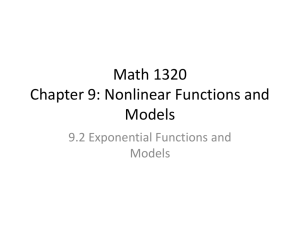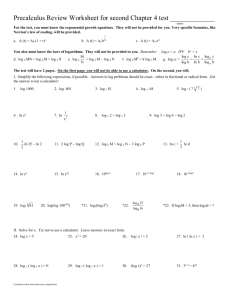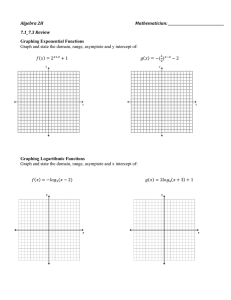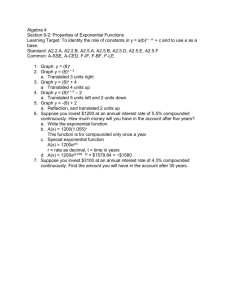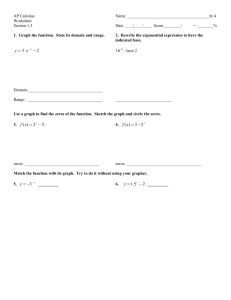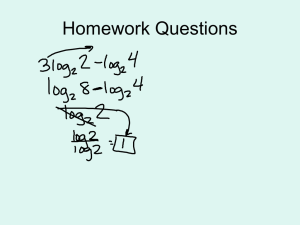Unit IV: Exponential Functions
advertisement
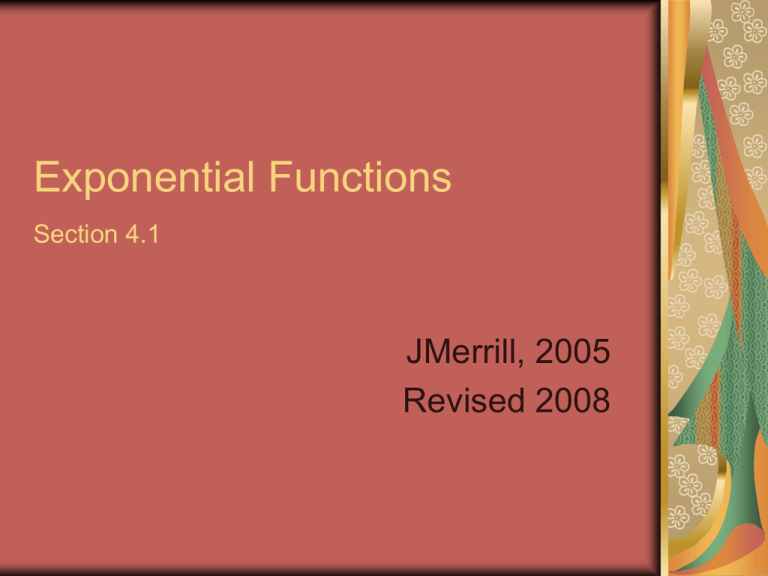
Exponential Functions Section 4.1 JMerrill, 2005 Revised 2008 Definition of Exponential Functions The exponential function f with a base b is defined by f(x) = bx where b is a positive constant other than 1 (b > 0, and b ≠ 1) and x is any real number. So, f(x) = 2x, looks like: Graphing Exponential Functions Four exponential functions have been graphed. Compare the graphs of functions where b > 1 to those where b < 1 1 y 7 1 y 2 x y 7x x y 2x Graphing Exponential Functions So, when b > 1, f(x) has a graph that goes up to the right and is an increasing function. When 0 < b < 1, f(x) has a graph that goes down to the right and is a decreasing function. Characteristics The domain of f(x) = bx consists of all real numbers (-, ). The range of f(x) = bx consists of all positive real numbers (0, ). The graphs of all exponential functions pass through the point (0,1). This is because f(o) = b0 = 1 (bo). The graph of f(x) = bx approaches but does not cross the x-axis. The x-axis is a horizontal asymptote. f(x) = bx is one-to-one and has an inverse that is a function. Transformations Vertical translation f(x) = bx + c Shifts the graph up if c > 0 Shifts the graph down if c < 0 y 2x y 2x 3 y 2x 4 Transformations Horizontal translation: g(x)=bx+c Shifts the graph to the left if c > 0 Shifts the graph to the right if c < 0 y 2x y 2( x 3) y 2( x 4) Transformations Reflecting g(x) = -bx reflects the graph about the x-axis. g(x) = b-x reflects the graph about the y-axis. y 2x y 2 x y 2 x Transformations Vertical stretching or shrinking, f(x)=cbx: Stretches the graph if c > 1 Shrinks the graph if 0<c<1 y 2x y 4(2 x ) 1 x y (2 ) 4 Transformations Horizontal stretching or shrinking, f(x)=bcx: Shinks the graph if c>1 Stretches the graph if 0 < c < 1 y 2x y 4(2 x ) 1 x y (2 ) 4 You Do Graph the function f(x) = 2(x-3) +2 Where is the horizontal asymptote? y=2 You Do, Part Deux Graph the function f(x) = 4(x+5) - 3 Where is the horizontal asymptote? y=-3 The Number e The number e is known as Euler’s number. Leonard Euler (1700’s) discovered it’s importance. The number e has physical meaning. It occurs naturally in any situation where a quantity increases at a rate proportional to its value, such as a bank account producing interest, or a population increasing as its members reproduce. The Number e - Definition An irrational number, symbolized by the letter e, appears as the base in many applied exponential functions. It models a variety of situations in which a quantity grows or decays continuously: money, drugs in the body, probabilities, population studies, atmospheric pressure, optics, and even spreading rumors! The number e is defined as the value that n 1 1 approaches as n gets larger and larger. n The Number e - Definition The table shows 1 A the values of 1 n as n gets increasingly large. 0 As n , the approximate value of e (to 9 decimal places) is ≈ 2.718281827 1 1 n n n n 1 2 2 2.25 5 2.48832 10 2.59374246 100 2.704813829 1000 2.716923932 10,000 2.718145927 100,000 2.718268237 1,000,000 2.718280469 1,000,000,000 2.718281827 n 1 As n , 1 e n The Number e - Definition For our purposes, we will use e ≈ 2.718. e is 2nd function on the division key on your calculator. y=e 1 y 1 n n The Number e - Definition Since 2 < e < 3, the graph of y = ex is between the graphs of y = 2x and y = 3x y= 3x y = ex y = 2x y =e ex is the 2nd function on the ln key on your calculator Natural Base The irrational number e, is called the natural base. The function f(x) = ex is called the natural exponential function. Compound Interest The formula for compound interest: r A(t ) P 1 n nt Where n is the number of times per year interest is being compounded and r is the annual rate. Compound Interest - Example Which plan yields the most interest? Plan A: A $1.00 investment with a 7.5% annual rate compounded monthly for 4 years Plan B: A $1.00 investment with a 7.2% annual rate compounded daily for 4 years 12(4) 0.075 1 1 1.3486 12 $1.35 365(4) B: 0.072 1 1 1.3337 365 A: $1.34 Interest Compounded Continuously If interest is compounded “all the time” (MUST use the word continuously), we use the formula A(t ) Pe rt where P is the initial principle (initial amount) A(t ) Pe rt If you invest $1.00 at a 7% annual rate that is compounded continuously, how much will you have in 4 years? 1* e (.07)(4) 1.3231 You will have a whopping $1.32 in 4 years! You Do You decide to invest $8000 for 6 years and have a choice between 2 accounts. The first pays 7% per year, compounded monthly. The second pays 6.85% per year, compounded continuously. Which is the better investment? You Do Answer 1st Plan: 12(6) 0.07 A(6) 8000 1 12 $12,160.84 2nd Plan: P(6) 8000e 0.0685(6) $12, 066.60

